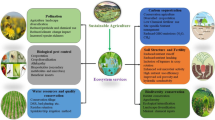Abstract
The past failure of large-scale, rural development in Amazonia has emphasized the value of small-scale, swidden-fallow management practices. The management strategies used by indigenous cultivators are well-documented, but few studies have examined how absorption by market-based economies may affect the economic and ecological stability of the agricultural system. In this study, we provide a detailed account of swidden-fallow management as it is practiced at Las Palmeras, Amazonas, Colombia; moreover, we assessed the effect of a shift from subsistence to market-directed production. A total of 68 species were selectively managed in the swidden/fallow system. Seventy-seven percent of species at the site were managed for subsistence only, 22% were managed with a view to selling surplus at market. Only one species, Cedrela odorata, was managed solely for market production. A shift from subsistence-based to market-directed production may lower the ecological and economic stability of the system at Las Palmeras. Nonperishable production strategies, such as for timber production, appear to provide the most secure approach toward market integration.
Similar content being viewed by others
References
Anderson, A. B., and Ioris, E. M. (1992). Valuing the rain forest: Economic strategies by small-scale forest extractivists in the Amazon estuary.Human Ecology 20: 337–369.
Balée, W., and Gély, A. (1989). Managed forrest succession in Amazonia: The Ka'apor case. In Posey, D. A., and Balée, W. (eds.),Resource Management in Amazonia: Indigenous and Folk Strategies. Advances in Economic Botany, No. 7, pp. 129–158.
Bates, H. W. (1863).The Naturalist on the River Amazons. John Murray, London.
Beckerman, S. (1983). Does the swidden ape the jungle?Human Ecology 11: 1–12.
Behrens, C. A. (1992). Labor specialization and the formation of markets for food in a Shipibo subsistence economy.Human Ecology 20: 435–462.
Cherrett, J. M., and Peregrine, D. J. (1976). A review of the status of leaf-cutting ants and their control.Annals of Applied Biology 84: 123–133.
Denevan, W. M., Treacy, J. M., Alcorn, J. B., Padoch, C., Denslow, J., and Paitan, S. F. (1984). Indigenous agroforestry in the Peruvian Amazon: Bora indian management of swidden fallows.Interciencia 9: 346–357.
Eden, M. J. (1987). Traditional shifting cultivation and the tropical forest system.Trends in Ecology and Evolution 2: 340–343.
Eden, M. J. (1990).Ecology and Land Management in Amazonia. Belhaven Press, London.
Eden, M. J., and Andrade, A. (1987). Ecological aspects of swidden cultivation among the Andoke and Witoto Indians of the Colombian Amazon.Human Ecology 15: 339–359.
Eden, M. J., and Andrade, A. (1988). Colonos agriculture and adaptation in the Colombian Amazon.Journal of Biogeography 15: 79–85.
Foster, R. B. (1973). Seasonality of Fruit Production and Seed Fall in a Tropical Forest Ecosystem in Panama. PhD dissertation, Duke University, Durham, North Carolina.
Hecht, S., Norgaard, R., and Possio, G. (1988). The economics of cattle ranching in eastern Amazonia.Interciencia 13: 233–240.
Hölldobler, B., and Wilson, E. O. (1990).The Ants. Springer-Verlag, London.
Humphries, S. (1993). The intensification of traditional agriculture among Yucatec Maya farmers: Facing up to the dilemma of livelihood sustainability.Human Ecology 221: 87–102.
Kohlhepp, G. (1989). A challenge to science and regional development policy-reflections on the future development of Amazonia.Applied Geography and Development 33: 52–67 (Institute for Scientific Co-operation, Tübingen).
Moran, E. F. (ed.) (1983).The Dilemma of Amazonian Development. Westview Press, Boulder.
Padoch, C., Chota Inuma, J., de Jong, W., and Unruh, J. (1985). Amazonian agroforestry: A market-oriented system in Peru.Agroforestry Systems 3: 47–58.
Posey, D. A. (1983). Indigenous ecological knowledge and development of the Amazon. In Moran, E. F. (ed.),The Dilemma of Amazonian Development. Westview Press, Boulder, CO, pp. 225–258.
Posey, D. A. (1985). Indigenous management of tropical forest ecosystems: The case of the Kayapó Indians of the Brazilian Amazon.Agroforestry Systems 3: 139–158.
Repetto, R., and Gillis, M. (1988).Public Policies and the Misuse of Forest Resources. Cambridge University Press, Cambridge.
Richards, P. (1985).Indigenous Agricultural Revolution. Hutchinson.
Salick, J. (1989). Ecological basis of Amuesha agriculture, Peruvian Upper Amazon. In Posey, D. A., and Balée, W. (eds.), Resource Management in Amazonia: Indigenous and Folk Strategies. Advances in Economic Botany, No. 7, pp. 189–212.
Seubert, C. F., Sanchez, P. A., and Valverde, C. (1977). Effects of land clearing methods on soil properties and crop performance in an Ultisol of the Amazon jungle of Peru.Tropical Agriculture Trimester 54: 307–322.
Staver, C. (1989). Why farmers rotate fields in maize-cassava-plantain bush fallow agriculture in the wet Peruvian Amazon.Human Ecology 17: 401–426.
ter Steege, H., and Persaud, C. A. (1991). The phenology of Guyanese timber species. A compilation of a century of observations.Vegetatio 95: 177–198.
Stocks, A. W. (1983). Candoshi and Cocamilla swiddens in eastern Peru.Human Ecology 11: 69–84.
Swift, M. J., and Sanchez, P. A. (1984). Biological management of tropical soil fertility for sustained productivity.Nature and Resources 20: 2–10.
Uhl, C., and Buschbacher, R. (1985). A disturbing synergism between cattle ranch burning practices and selective tree harvesting in the Eastern Amazon.Biotropica 17: 265–268.
Uhl, C., and Murphy, P. (1981). A comparison of productivities and energy values between slash and burn agriculture and secondary succession in the Upper Rio Negro region of the Amazon Basin.Agro-ecosystems 7: 63–83.
Unruh, J. D. (1990). Iterative increase of economic tree species in managed swidden-fallows of the Amazon.Agroforestry Systems 11: 175–197.
Walschburger, T., and von Hildebrand, P. (1988). Observacoines sobre la utilizacion estacional del bosque humedo tropical por los indigenas del Rio Miriti.Colombia Amazonica 3: 51–74.
Weischet, W., and Caviedes, C. N. (1993).The Persisting Ecological Constraints of Tropical Agriculture. Longman, Harlow.
Wilken, G. C. (1989). Transferring traditional technology: A bottom-up approach for fragile lands. In Browder, J. (ed.),Fragile Lands of Latin America: Strategies for Sustainable Development. Westview Press, Boulder.
Author information
Authors and Affiliations
Rights and permissions
About this article
Cite this article
Hammond, D.S., Dolman, P.M. & Watkinson, A.R. Modern ticuna swidden-fallow management in the Colombian Amazon: Ecologically integrating market strategies and subsistence-driven economies?. Hum Ecol 23, 335–356 (1995). https://doi.org/10.1007/BF01190136
Issue Date:
DOI: https://doi.org/10.1007/BF01190136




